Riverbank Management in Suburban Winchester, Massachusetts
By Reed Pugh and Miles Connors
Winchester, Massachusetts, like several old New England towns, is situated on the banks of a tranquil, winding river. The Aberjona River, which flows through town, is connected by two small ponds (Mill and Judkins) and empties into Mystic Lake before moving south to Boston Harbor and the Atlantic Ocean. Historic bridges and many buildings have been built along the river and around the ponds making it a crucial part of town center, with the iconic Center Falls Dam being the centerpiece.
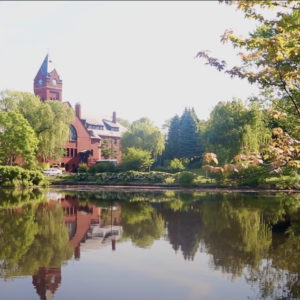
Mill Pond with Town Hall and the Library in the background. Photo courtesy of James Shiang, Shiang Studios.
Like many waterways, our Aberjona River has become home to many non-native and invasive plants that have largely overwhelmed our native plant palette. These invasives have also obstructed much of the river and ponds from views and access by residents and visitors. The invasive plants have been brought in by wildlife, wind, and the flowing river. The worst offenders are well known to professionals and homeowners alike: Multiflora Rose (Rosa multiflora), Japanese Knotweed (Fallopia japonica), Buckthorn (Rhamnus cathartica), Tree of Heaven (Ailanthus altissima), Japanese Honeysuckle (Lonicera japonica), Oriental Bittersweet (Celastrus orbiculatus), Purple Loosestrife (Lythrum salicaria) and many others.
A layer of native plants exists along the banks, mostly being out competed by the more aggressive invasive plants and sprawling vines. If left unchecked, the invasives will soon largely eliminate the native layer.
Prior to environmental laws enacted in the latter part of the last century, banks along our rivers and ponds were cut and maintained right down to the water, which eliminated plant growth and kept the banks clean, but there was no habitat for wildlife and little aesthetic beauty.
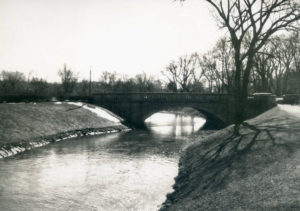
Riverbank from the 1950s prior to the establishment of environmental laws. Photo courtesy of Winchester Archival Center.
With environmental laws protecting the water resources and their banks, little work, other than the occasional removal of larger trees, has been done on the banks to maintain the vegetative border. It has become a dense and overwhelming mix of predominantly non-native plants. As stewards of this resource, the Conservation Commission wants to properly care for the river and pond banks and create an ongoing program to ensure its health and beneficial habitat, as well as make it a beautiful and accessible destination.
Aberjona River Initiative
In 2015, the Winchester Conservation Commission established the Aberjona Initiative, a working group of the Conservation Commission, tasked with restoring the river and pond banks in town center. The goal is to regain access and views to this beautiful resource and maintain a significant plant buffer to support local wildlife. The process is to remove, with minimal disturbance to the bank, non-native, invasive plants and replace them with native trees, shrubs, and herbaceous perennials. Over the past decade, with work by Juli Riemenschneider, Senior Landscape Architect at Green International, we have developed a detailed mapping of invasive plants and a Landscape Master Plan to guide our work.
While it may sound easy, the main challenges have been to secure funding for the work and for ongoing maintenance and to find a competent team to perform the work. The town’s Department of Public Works is very capable of performing a lot of heavy lifting in removing larger material. But they do not have the staff with licensing and experience to perform the more detailed work of identifying and removing invasives, applying herbicide, and planting new material. They continue to be an important part of the process in helping us remove large material.
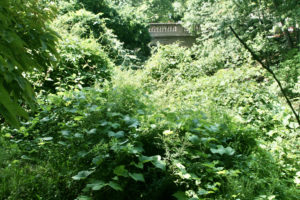
Dense growth and layers of invasive plants obscure views of the Aberjona River. Photo courtesy of Reed Pugh.
Beginning in 2019, Miles Connors, Director of Parterre Ecological, was brought in to help the Aberjona Initiative create a plan for the proper stewardship of the pond edge. Miles and a team of Field Technicians began restoration efforts on Mill Pond. This initial restoration is intended to show the positive impact that a native plant community can have on the beauty of town center, visitation and commerce, and the health of the river ecosystem. With this initial success, we are now planning to expand their work all along the waterway.
Seasonal Approach To Plant Management
The Parterre Ecological approach has been to gain familiarity with the plant community surrounding the pond, including creating a seasonal plan to manage the immense biomass of non-native, invasive plants. It wasn’t until this current third season that they began planting and seeding herbaceous native plants. Their stewardship of the pond has helped to reverse the succession of many of the worst invasive plants.
In their first season, they began cutting invasive plant species from an overgrown Yew (Taxus) hedge along the pond and pruning the yew to allow greater views of the pond from above. Through this hedge grew Tree of Heaven, Bittersweet, Multiflora Rose, and other invasive plant species. At this time, they also began controlling extensive populations of invasive plants from around the perimeter of the pond. Invasive plant species often have persistent and well-established root systems.
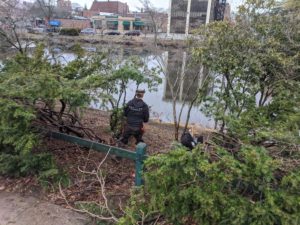
Parterre Ecological hard pruning Yew hedge and removing invasive plant growing through the hedge. Photo courtesy of Parterre Ecological.
Parterre waited until late summer to “Cut and Dab” sprouts from the root system of invasive species with herbicide. cut-and-dab is a technique that a licensed applicator will utilize to initially cut and remove larger material and then “dab” the cut stump with an approved herbicide. The dabbing needs to be done immediately after the cut is made so that the living tissue will absorb the herbicide into the plant’s vascular system, reducing its ability to resprout from the roots over time. Dabbing is done on all woody and perennial plants that are large enough (over 3/4″ diameter) that can’t be removed without too much disturbance.
As part of their ongoing stewardship of the pond, Parterre approaches their work on a seasonal basis. Early spring (before leaf buds open into leaf) is a time to consider live staking (planting dormant cut stems of specific native plant species) like Dogwood (Cornus species), Elderberry (Sambucus canadensis), Buttonbush (Cephalanthus occidentalis), and Willow (Salix species). Another important early season work is dormant seeding methods (adding native seed species to cold soil before the growing season) and beginning to plant landscape plugs. Native wetland and upland wildflower species are often purchased as 32 or 50 quantity trays of 2” inch plugs. Parterre purchases much of their native plug material from reputable local nurseries, but they also have been doing some custom growing. Following is a partial list of native wildflower and grass plugs installed:
Blue-Flag Iris (Iris versicolor)
Swamp Milkweed (Asclepias incarnata)
Monkey Flower (Mimulus ringens)
Northern Sea Oats (Chasmanthium latifolium)
Sweet Coneflower (Rudbeckia subtomentosa)
Heath Aster (Symphyotrichum ericoides)
Bushy Bluestem (Andropogon glomeratus)
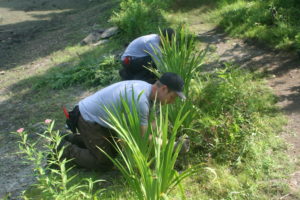
Alexi Dart-Padover and Gretchen Exely-Smith of Parterre Ecological planting plugs along a disturbed part of the pond bank. Photo courtesy of Reed Pugh.
Parterre Ecological manages early spring risers before they go to seed, including Garlic Mustard (Alliaria petiolata) and Greater Celandine (Chelidonium majus). Spring is also an important time to initially cut and remove invasive plant species before the leaves emerge, reducing the density and biomass. Since all plants are pushing new growth up from their root system in spring, cut-and-dab herbicide application is not recommended. In spring, all plants push out nutrients and water to aid in their growth and will not readily take in and store nutrients (or an herbicide) from the stem.
Summer work around the pond consists mainly of identifying and continuing to remove the unwanted invasives and managing seasonal annuals before they go to seed. On smaller material with stems less than ¾-inch diameter, they often hand-pull the plants. Along with planting plugs, Parterre sows a custom, native seed mix to areas of exposed soil or disturbed soil after plant removal. They use a base mix and add straight species based on the existing conditions of the site. At Mill Pond, the seed mix primarily consists of several sedges and rushes that spread well along banks, with additional perennials like Blue Vervain (Verbena hastata), Swamp Aster (Symphyotrichum puniceum), and Spotted Joe Pye Weed (Eupatorium maculatum), Boneset (Eutrochium maculatum)and Tall Meadow Rue (Thalictrum pubescens), among others.
This restoration work continues into the fall when the herbicide is most effective as invasive plants are in the process of storing reserves for winter dormancy. Late fall is also one of the best times of the year for planting and live staking.
This September, Parterre will be starting work on a new area along the river. They will be cutting back several large clumps of Knotweed and applying herbicide as this is the most effective time to manage this insidious, invasive plant.
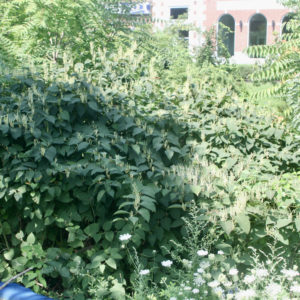
Parterre will manage large clumps of Japanese Knotweed this September by cutting plants and dabbing herbicide on cut stems. Photo courtesy of Reed Pugh.
As we continue our restoration work around the pond, we are trying to leave many areas open with viewsheds across the pond so visitors can see the pond and surrounding architecture. Smaller herbaceous perennials can provide beautiful cover for the bank and habitat without obscuring views. However, in many areas with steeper banks requiring erosion control measures, we will be planting more woody and structured plants designed to better hold the banks and stem erosion.
Native Plant Layer Adds Beauty to Riverscape
While it is still early in the process, we are working to secure funding from the town to complete larger parts of the project. The impact of invasive removal on Mill Pond combined with some limited planting of flowering perennials and seeding has raised the profile of our work around town government and with residents. In September, we are starting work on a second section of the river in town center that is completely inaccessible with large clumps of Knotweed and huge mats of Bittersweet and Multiflora Rose (See image #3). As described earlier, it is a process that requires patience and discipline to properly remove the invasive material without great disturbance. Still, we expect to have the bank properly planted and thriving with beautiful and appropriate native plant material in two years.
Several years ago, Winchester’s town center was designated as a Massachusetts Cultural District, and the organization uses town center and the waterways for art exhibits and events. With the current and planned improvements, including a riverwalk and bike path, we anticipate this area will be an attraction for residents and visitors and a desirable location for local business events and town gatherings.
Winchester is a town that was primarily planned and built around the river over several centuries. It is important that the current work balances critical riverbank and habitat protection with the desire for residents and visitors to be able to appreciate such a beautiful and valuable resource.
To see more about this project, click the link to view a recent video: Winchester Aberjona Initiative.
About the Authors
Reed Pugh is a horticulturist, landscape designer, and consultant working in the suburbs of Boston. He works mostly with homeowners with an interest in their gardens and who are passionate to learn more. He teaches a series of pruning workshops and classes at Tower Hill Botanic Garden and is an appointed member of the Winchester Conservation Commission.
Miles Connors is Director of Parterre Ecological, a division of Parterre Garden Services. Parterre Ecological provides land management planning, expert invasive plant management, and native plant restoration strategies in the greater Boston area.
***
Each author appearing herein retains original copyright. Right to reproduce or disseminate all material herein, including to Columbia University Library’s CAUSEWAY Project, is otherwise reserved by ELA. Please contact ELA for permission to reprint.
Mention of products is not intended to constitute endorsement. Opinions expressed in this newsletter article do not necessarily represent those of ELA’s directors, staff, or members.

